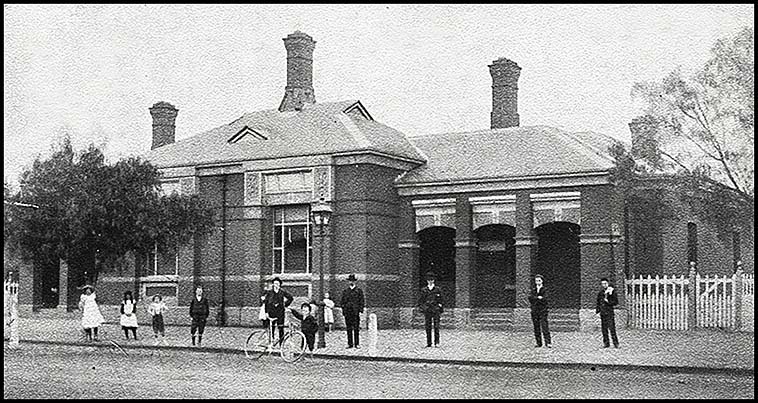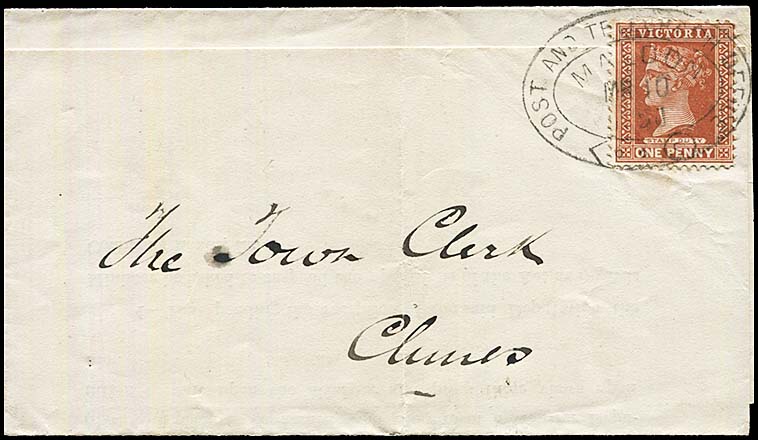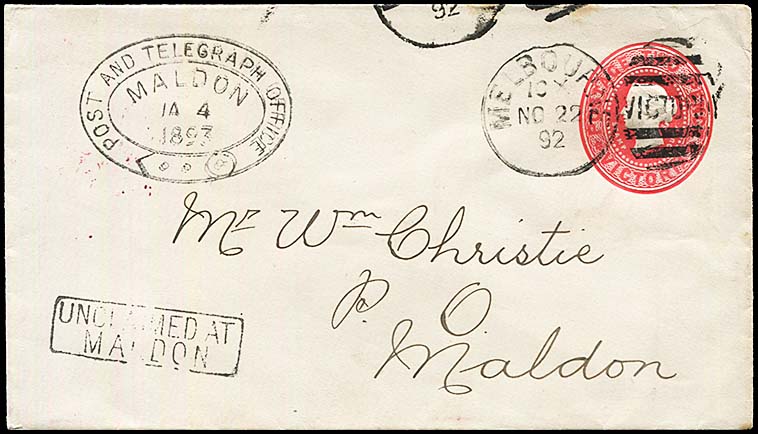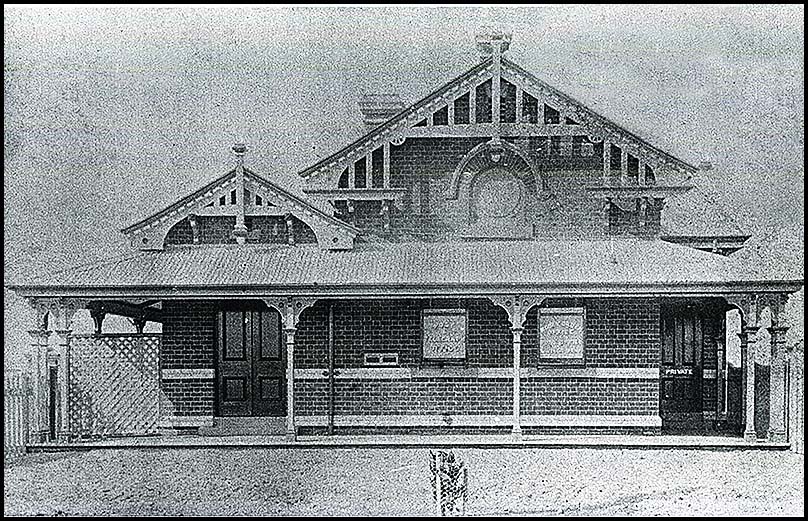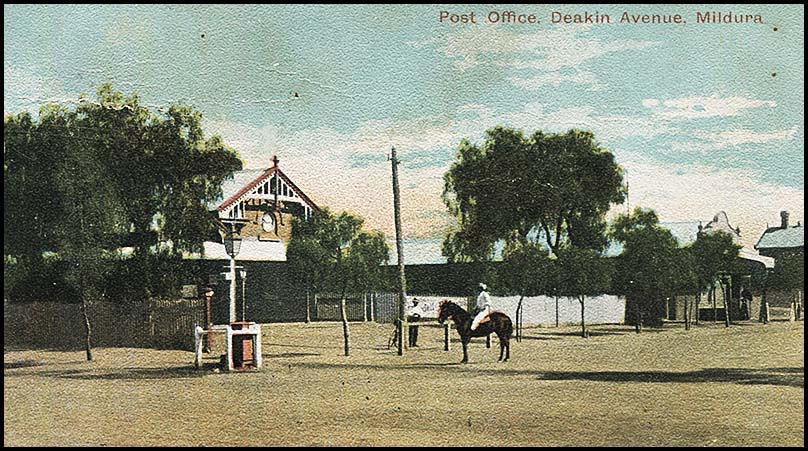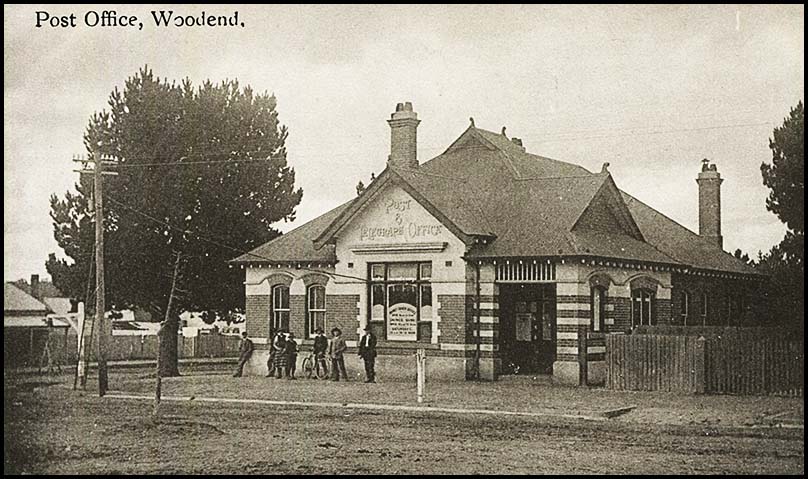Telegraph Offices on the Swan Hill (No. 1 North) line.
- Australia 1901-1988
- New South Wales
- Overview of NSW
- Telegraph lines
- Telegraph Offices
- Date stamps
- Forms
- Envelopes
- Instructional annotation
- Collect
- Delayed
- Free
- Immediate Urgent
- Reply paid
- Rates
- Stamps
- 1871 Telegraph stamps
- 1885 proposal
- 1893 proposal
- Queensland
- South Australia
- Tasmania
- Victoria
- Western Australia
- International
- Special aspects
The following stations were included on the Swan Hill line:
| Barfold | Cowans | Durham Ox | Eddington | Kerang | Swam Hill |
| Macedon | Malmesbury | Merebin | Mildura | Mincha | Robinvale |
| Serpentine | Swan Hill | Taradale | Tragowel | Woodend |
|
Located about 25 kilometres east of Castlemaine. The Office was created by renaming the office at Emberton in 1867. A Post Office was opened at Emberton on 4 January 1867 with Mr. Hugh McLennon in charge. A Telegraph Office was established at the Railway Station about 1910. That office was reclassified as a Post Office about 1915 but was (allegedly) closed in 1917. Clearly the telegraph duties were maintained for some time. |
||
It appears that the office was issued with a T.O. Barfold date stamp although a strike has never been seen nor recorded. Instead, a date stamp with a space before Barfold - sufficient to accommodate T.O. - is recorded:
|
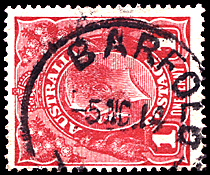 5 November 1914. |
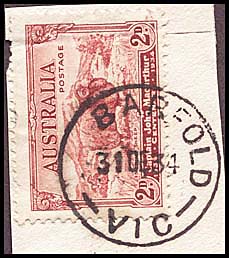 31 December 1934. |
 11 November 1941. |
||
|
Opened as a Post Office on 17 October 1927 and was reclassified as a Telegraph Office on 1 December 1942. The Office was closed on 10 June 1949. A steel circular date stamp for postal and telegraphic use is reported to have been used between 3 March 1933 and 30 June 1941. It is rated as RR. |
|
The date stamp shown here preceeds that early date by over 3 years.
|
 4 December 1929. |
|
The Telegraph Office opened in June 1876. |
|
The town was situated at the crossing of the Loddon River between Dunnolly and Maldon. A bridge was constructed in 1861 and that replaced a punt which had operated for a number of years. The bridge was used frequently by the Cobb & Co coaches. In 1863, floods nearly destroyed the Eddington Bridge and caused considerable loss of life. Gold mining in the region spurred growth of the township and a variety of stores, hotels and manufacturing enterprises were established to support the increasing number of people attracted to the mining in the general area. One of the main enterprises was the Eddington Cheese and Butter factory. The Eddington Race Meetings and Ploughing competitions were always well-attended The Post Office - opened on 1 November 1861 - was situated on McCoy Street. The Bendigo Advertiser of 19 November 1884 proudly announced that "At last, after a deal of agitating, we have a telegraph ofiice opened here which will be a great convenience to our residents. Miss Ryan, daughter to Mr. T. Ryan, has been appointed postmistress, etc.". A collection of interesting photos of the town in the late 1800s and in the 2000's are included in an excellent local history website. |
| Kerang.
The Telegraph Office opened on 7 August 1863. |
|
|
|
|
|
The Bendigo Advertiser of 25 June 1868 carried the important story that: "A deputation from the Swan Hill District Road Board was introduced to the Chief Secretary this morning by the Hon N. Fitzgerald, M.L.C. and Mr Thomas, M.L.A. The object of the deputation was to protest against the removal of the Post Office from Kerang to a place about three miles distant from the township. The gentlemen present stated that at present the Post Office and Telegraph Office were under one roof in the heart of the township, but it was proposed to move the Post Office to a store about three miles distant where it would only benefit one person. The Chief Secretary said he would look over the papers and inquire into the affair and the deputation then withdrew". On 2 July, the Advertiser published a follow-up story: "A Kerang correspondent writing to the Age contradicts the statement made by a recent deputation to the Chief Secretary, that it was proposed to remove the local Post Oflice from the township to a store three miles distant. On the contrary, he says the inhabitants of Kerang seek to have the Post Office removed to the surveyed township, from the property of a storekeeper three miles distant. The Post Office has been continued in its present position only in consequence of the Telegraph Department having leased for five years the building that now serves both as Post and Telegraph offices, but now the lease is nearly expired". On 27 July 1868, the arguments waged on in the Advertiser involving also the Court House - see page 3 elsewhere. The Riverine Herald of 13 March 1869 relates the following story: "Our telegraph office has been closed for the last five days, owing to some departmental changes ... But to return to the closing of the telegraph office: In the name of electricity, let us have one or none at all so that people from a distance may know whether they can send a message or not. The day after our telegraph master, in obedience to his instructions, had put the key of his office into his pocket and, without beat of drum, drove off to the Serpentine then came a gentleman post haste to send an important telegram about some travelling sheep he had under his charge. It was some time before he could realise the fact that the office had been closed without any public notice being given. When, however, he found that it was impossible to send the message, he got upon his already nearly tired horse and rode forty miles into Swan Hill. The Government have treated us in a very off-hand and cavalier manner in this respect. If the office does not pay it is surely worth their while to ascertain whether private subscriptions could not be raised to guarantee a portion of the working expenses. I suppose that, since the office has been open, the value of the messages sent has been greater than in most country telegraph offices for they nearly all refer to the sale of stations and the market price of stock of which the sender has, perhaps, £2,000 worth under his charge — sudden sickness, criminal information to the police and the like. The telegraph wires, like the Post Offices, are not supposed to be a source of revenue, but when an office that has been built by private enterprise, placed in the hands of the Government at a nominal rent and kept open for several years, is abruptly closed for a week without the least notice being given to the public, it is high time to ask the Government for a precedent which I suspect would puzzle them to find". The Kerang Times of 19 August 1884 reported on the condition of the Post and Telegraph Office as follows:
|
|
| Personnel:
June 1863: John L'Estage appointed Acting Operator of Electric Telegraph and Collector of Imposts, also to act as Postmaster at Kerang from 1st July, 1863. In April 1867, he was transferred to Gisborne. April 1867: Mr. William Thomas Swann appointed line repairer in charge of Electric Telegraph and collector of imposts also to act as postmaster at Kerang from the 11th March, 1867 vice J. L'Estage". February 1869: Frank O'Connell appointed line repairer in charge of electric telegraph and collector of imposts at Kerang from 1st January, 1869, vice W. T. Swann transferred. |
|
| Early forms:
The earliest indication of the operation of the Kerang Telegraph Office is a message on a telegram delivery form (VC-DO-11C) at Sandhurst on 12 November 1887 from Kerang. |
|
| Date stamps.
Two formats for date stamps were issued th the Kerang Office for use with telegraphs. A 1 hole Belt & Buckle date stamp was issued to the Post & Telegraph Office at Kerang. |
|
|
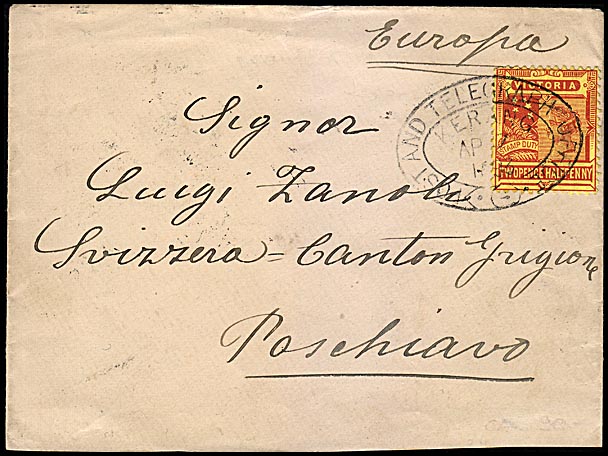 7 April 1893. Cover to Poschiavo, Italy. |
| Use on a ½d pink wrapper to Melbourne. | 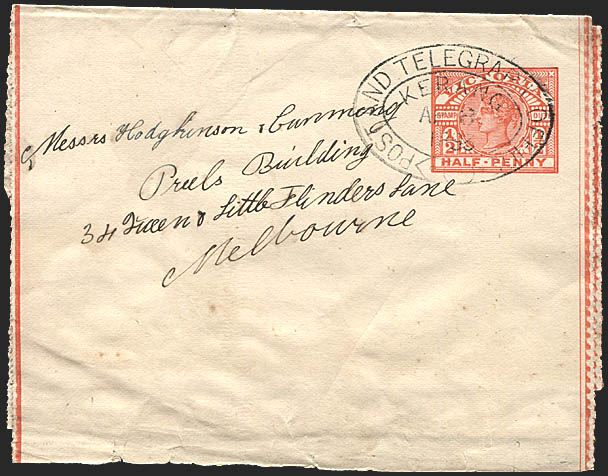 8 April 1893. |
| 2 May 1893: latest recorded use of a Kerang Belt & Buckle.
A 1 hole Kerang Belt & Buckle date stamp used in black as an arrival backstamp on a Letter Card sent from Swan Hill.
|
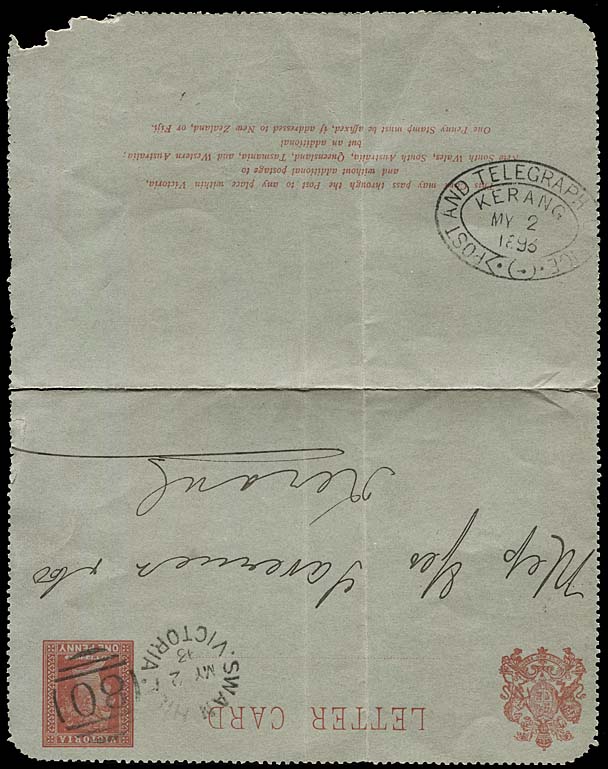 |
| Additional examples of usage. | 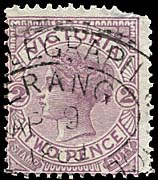 9 April 1899. |
 23 July 1890. Used on 1½d letter card for local delivery. |
| A rectangular TELEGRAPH OFFICE date stamp (RRH1-TO) was also used at Kerang:
|
 13 September 1968. |
|
| Usual postal date stamp also used on telegrams. | 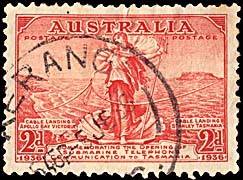 5 June 1936.
|
The Argus of 23 May 1864 reported on the honesty of the Telegraph Messenger as follows:
|
|
|
 Detail of the Belt & Buckle date stamp on the newspaper wrapper below. |
|
 Detail of the Belt & Buckle date stamp on the embossed pre-stamped cover below. |
|
|
The Telegraph Office opened in October 1865. A Telegraph Office was also opened at the Railway Station in 1889 but later closed. It was reopened about 1910 and closed about 1916. |
|
Merbein is next to Mildura. |
|
The Office was issued with a rubber oval Telegraph Office at some stage.
|
 14 March 1989. Archival strike. |
|
A Post Office was opened on 13 December 1866. Metcalfe East was a change of name from East Metcalfe about 1914 and closed on 21 September 1968. |
|
The offices was issued with a circular steel date stamp some time after 1918.
|
 2 August 1922. Only recorded example. On 9d volet Roo 3rd watermark. |
During May 1932, the year wheel on the date stamp was inverted but the problem was not corrected for nearly a month.
|
 26 May 1932 with the "2" inverted. Only recorded for about one month. |
In the 1940s, the year wheel was missing. It is not known when this occurred.
|
 20 March 194(?). Year wheel now missing. |
| The Office was issued with five types of rubber date stamp for use with telegrams: | |
|
|
 9 September 1931. Used on AB-DO-8A. |
|
|
 14 February 1952. |
|
 26 November 1959. |
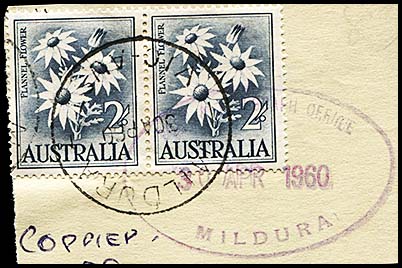 30 April 1960. |
|
|
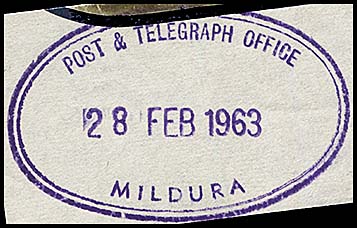 28 February 1963. Used on a delivery envelope. |
|
 |
|
 9 July 1968. Used on a delivery envelope. |
|
 6 November 1972. Used on Confirmatory delivery envelope AA-EC-3. |
|
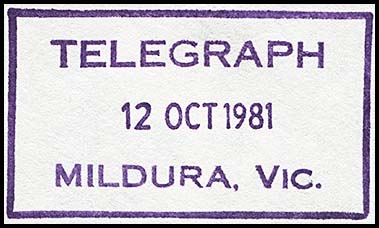 12 October 1981. |
| In addition, the usual postal date stamps were used on telegrams: |  Mildura duplex with date stamp and barred numeral 1620. 30 October 1908. |
 Mildura - usual postal date stamp. 11 August 1923. Diameter: 26 mm. |
| Mincha.
The Mincha Railway Station changed name to Mincha in 1902. The office closed on 1 April 1977. |
|||
A T.O. Mincha date stamp is recorded:
|
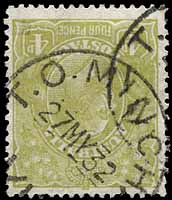 27 May 1932. Earliest recorded date. |
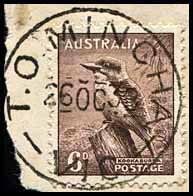 26 October 1933. |
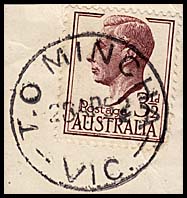 23 April 1952. |
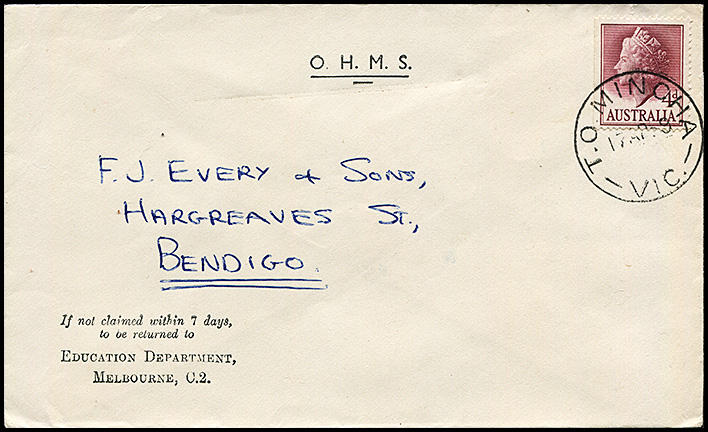 17 April 1959. Rare on cover. |
|
The Empire of 13 March 1869 reprinred an article from the Argus: "The telegraph station at Newstead is to be continued. Miss Firman, the daughter of the Postmaster, is to act as electrician and Postmistress and thus, while saving expenditure to the Government, she will be able to meet the wants of Newstead in this matter. We think it possible that female electricians could be more generally employed in the telegraph department as they are in England. They send messages as carefully and as efficiently as men do. In such a township, for instance, as Jerilderie, a female electrician could be employed and also perform the duties of postmistress. In England the system answers well and we cannot see why it should not be introduced in Australia". |
|
A Receiving Office was established at Bumbong about 1924. It was renamed Robinvale on 1 August 1924. It was then upgraded to a Post Office on 14 July 1926. It has Euston as its sister City which is located on the other side of the Murray River in New South Wales. |
| No special date stamp was used for telegrams. Instead the usual Post Office date stamp was used. |
|
| Serpentine (Creek).
The Telegraph Office opened on 12 January 1869 immediately after the telegraph line was connected. The Gazette of 19 February 1869 announced "Wm. T. Swan, to be line repairer in charge of Electric Telegraph and collector of imposts at Serpentine from the 1st of January, 1869". Mr. Swan had previously been at Kerang - and that is a story in itself. On 3 February 1870 the office was closed (Annual Report, p. 8). "In the East Loddon district, the Road Board in the first instance negotiated with the Government for the purpose of having a telegraph station established at the Serpentine within the district After a considerable amount of correspondence, the Government agreed on condition that a bond was signed by any responsible persons in the district to reimburse the department for any deficiency that might accrue. This bond was signed by all the members of the board and three persons besides (ratepayers). At the end of the year, on petition to the department, the office was closed, and an account of the deficiency forwarded. The board now consists of different persons to what it did at the time of the negotiation. The ratepayers do not object to the board's paying the amount due, instead of getting it from private individuals. As the office was established for the benefit of the district, cannot the present board relieve the signers to the bond of their liability? Certainly. This case is a fair sample of many where a public benefit is sought to be conferred by the members becoming personally liable. The public body should always pay the debt so incurred where, as in this instance, it is straightforward and
bond fide". The Office was re-opened on 16 September 1873 (Annual Report, p. 8). The town was established as Serpentine Creek in 1863 and the Post Office was opened in 1868. In 1917, the name was changed to Serpentine.
|
|
| Swan Hill.
The Telegraph Office was opened in April 1863. The Geelong Advertiser had added to that announcement "Castle Donnington is the official name for Swan Hill but we prefer the old designation".
|
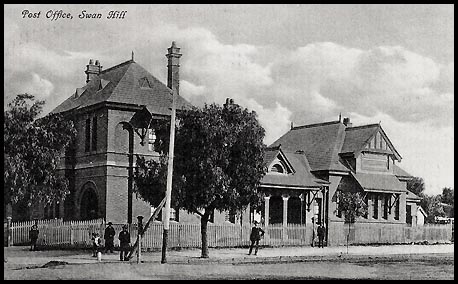 Swan Hill Post & Telegraph Office about 1900. |
|
Personnel: April 1863: Alfred Lionel Krone to be Manager of Electric Telegraph and Collector of Imposts, also to act as Postmaster at Swan Hill from 1st April, 1863. |
||
| The Gazette of 8 August 1862 announced that a tender for the purchase of a building for a Post and Telegraph Office at Swan Hill had been agreed with D. S. Campbell and Judd for £900. The Gazette of 23 December 1862 indicated that a contract had been accepted with G. R. Reynolds for the Post and Telegraph Office at Swan Hill for £981 5s - presumably for renovations. | ||
Early forms: The earliest telegram for Swan Hill is a Reply-Paid message received at Sandhurst on 23 May1887 from Sean Hill and copied onto a telegram delivery form (VC-DO-11C). This date stamp for Sandhurst is rare because it is stamped in blue. |
||
| Date stamps.
Two date stamps were issued to Swan Hill for use with telegraphic matters: |
||
|
|
|
|
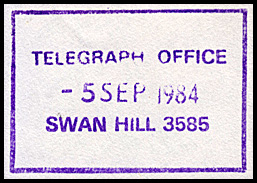 5 September 1984. |
|
|
The Telegraph Office opened on 30 November 1861. Henry Ellis was appointed Operator in Charge of the Electric Telegraph at Taradale and also to act as Postmaster from 27 Decenber 1861. The Gazette of 20 March 1866 announced the appointment of James B. Matthews to be acting manager of the Electric Telegraph and Collector of Imposts also Postmaster at Taradale from 1st March 1866 vice Mr. W. H. Hollick. |
| Tragowel.
Tragowel is south of Kerang. The Telegraph Office was opened in May 1878 while the Post Office was opened in June 1878. It closed on 3 November 1976. |
||
The office was issued with a T. O. Tragowel date stamp:
|
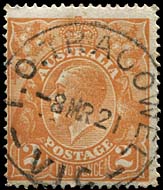 8 March 1921. |
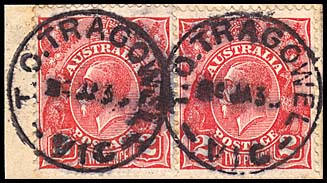 January 193? |
|
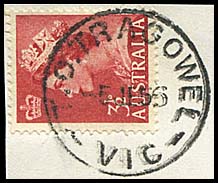 5 June 1956. |
 20 June 1958. |
